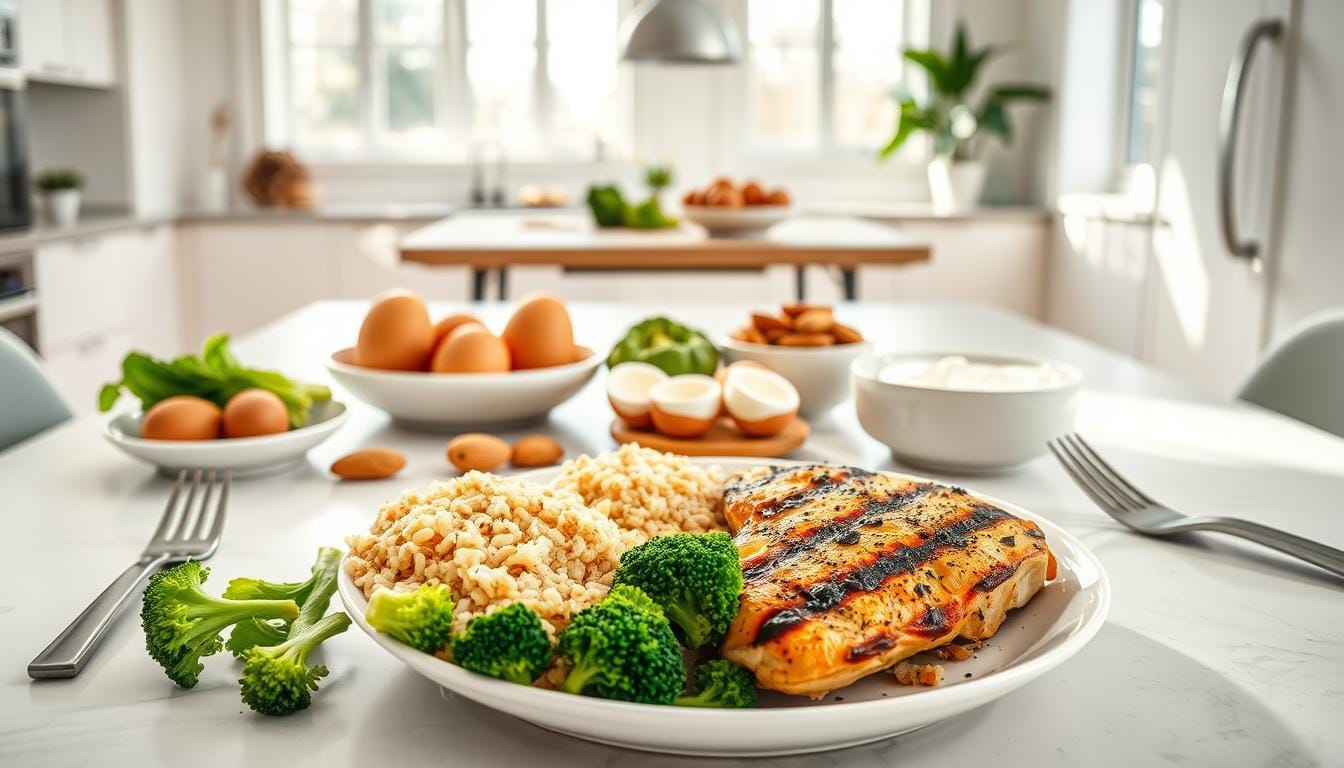Lose Weight This Week: A 1200-Calorie High-Protein diet Plan
Have you ever stared at the scale, frustrated by numbers that refuse to budge? You’re not alone. Many people feel stuck in cycles of restrictive eating or confusing routines that leave them hungry and drained. What if there was a way to fuel your body while steadily moving toward your goals?
This 1,200-calorie strategy combines precise calorie control with protein-rich meals to keep energy levels stable. Research from Medical News Today shows that prioritizing protein helps maintain muscle mass during weight loss, making results more sustainable. Think grilled chicken salads, scrambled eggs with veggies, or Greek yogurt bowls—meals designed to satisfy cravings without excess calories.
You’ll learn how lean meats, eggs, and dairy create balanced plates that work with your body, not against it. The plan focuses on simplicity: no exotic ingredients or hours in the kitchen. Instead, it offers clear guidelines to help you understand portion sizes and nutrient timing.
Why does this approach stand out? Protein keeps you fuller longer, reducing the urge to snack mindlessly. Combined with strategic calorie limits, it creates a powerful synergy for shedding pounds. Good Food emphasizes that sustainable weight management isn’t about deprivation—it’s about smart choices you can maintain week after week.
Ready to take control? Let’s explore how this method can jumpstart your journey while keeping meals flavorful and satisfying.
Table of Contents
Overview of the 1200-Calorie Meal Plan
What makes a 1,200-calorie strategy effective? It’s not just about cutting calories—it’s about precision and balance. This plan focuses on three pillars: controlled portions, nutrient-rich foods, and enough protein to keep your body functioning optimally.
Protein intake is carefully calculated here. Most adults need 0.8-1.2 grams per pound of body weight daily, according to Medical News Today. Hitting this target helps preserve muscle while losing fat. Think grilled turkey patties, scrambled egg whites, or black bean salads—meals designed to meet needs without excess calories.
The plan prioritizes whole foods like:
- Lean meats (chicken, fish)
- Fiber-packed veggies (broccoli, spinach)
- Complex carbs (quinoa, sweet potatoes)
These choices deliver vitamins and minerals that support overall health. You’ll also learn to adjust portions based on activity levels. A desk job vs. daily workouts? The plan adapts.
Why does this work? Protein keeps hunger hormones steady, while smart carb timing fuels your body. Combined with calorie limits, it creates a sustainable path to results. And yes—there’s room for dark chocolate or berries when cravings strike.
This isn’t a one-size-fits-all approach. Whether you’re vegetarian or managing allergies, the framework stays flexible. The goal? A routine that fits your life while keeping energy high and progress consistent.
Understanding the High-protein diet for Weight Loss
Why does protein play a starring role in effective weight management? Studies show it boosts metabolism by up to 35% during digestion compared to fats or carbs. This “thermic effect” means your body burns more calories breaking down protein-rich meals.
How Protein Accelerates Results
Eating enough protein per meal helps maintain muscle mass during calorie deficits. Medical News Today notes that for every pound you weigh, consuming 0.8-1.2 grams daily preserves lean tissue while targeting fat stores. This balance prevents metabolic slowdown—a common hurdle in long-term weight loss.
Essential Amino Acids: Your Metabolic Allies
Your body needs nine amino acids it can’t produce alone. These building blocks:
- Repair muscle fibers after activity
- Support hormone production
- Enhance nutrient absorption
Research reveals that meals rich in these compounds increase satiety by 35% compared to low-protein options. Spreading intake across meals ensures a steady supply for muscle repair and energy needs.
Clinical trials highlight another benefit: those prioritizing protein consume 441 fewer calories daily on average. By focusing on quality sources and timing, you create a system where your biology works with your goals.
Optimizing Your Calorie Intake with a High-Protein Approach
How do you ensure every calorie counts while fueling your body efficiently? The answer lies in strategic nutrient pairing. By focusing on foods high in protein and essential vitamins, you create meals that support weight goals without sacrificing satisfaction.
Balancing Macronutrients for Success
Your plate should work like a team: proteins, carbs, and fats each play specific roles. Medical News Today emphasizes that nutrient-dense choices become vital when managing intake. Try these strategies:
- Prioritize lean protein sources like fish or tofu at every meal
- Pair them with fiber-rich veggies to slow digestion
- Add complex carbs post-workout for energy replenishment
Aim for a 40-30-30 ratio (protein-carbs-fats) as a starting point. This balance keeps blood sugar stable while maximizing muscle support.
Integrating Nutrient-Dense Foods
Not all proteins are created equal. Focus on sources offering extra benefits:
- Eggs: Packed with B vitamins for energy metabolism
- Greek yogurt: Provides calcium for bone health
- Turkey breast: Low in fat but rich in iron
Legumes and lentils double as protein and fiber sources, making them perfect for plant-based diets. By choosing these foods high in multiple nutrients, you amplify results without increasing intake.
Benefits of a High-Protein Diet for Weight Loss
What if your meals could keep you full longer while protecting your muscles? Research reveals that protein-rich eating patterns offer unique advantages for sustainable results. Let’s explore how this approach supports both your scale victories and overall health.
Staying Fuller, Eating Less
Protein triggers hormones like PYY and GLP-1, which signal fullness to your brain. A study in Nutrition & Metabolism found participants ate 12% fewer calories when meals contained 30% protein. Compare this to traditional low-protein plans where hunger often derails progress.
Protecting Your Metabolic Engine
Muscle loss during calorie deficits slows metabolism. Here’s where essential amino acids shine. These compounds:
- Repair exercise-induced muscle tears
- Support hormone production
- Boost nutrient absorption
By consuming 25-30 grams of quality protein per meal, you maintain lean mass. This keeps your metabolic rate steady—critical for long-term success.
Practical tip: Pair Greek yogurt with almonds for a snack. The combo delivers casein protein and healthy fats, curbing cravings for hours. Unlike carb-heavy snacks, this strategy stabilizes energy while aligning with weight goals.
Diverse Protein Sources to Fuel Your Plan
Variety isn’t just the spice of life—it’s the key to unlocking your body’s full potential. Mixing protein sources ensures you get all nine essential amino acids while supporting kidney health and metabolic efficiency. Let’s explore options that keep meals exciting and nutritionally complete.
Animal-Based Protein Options
Animal proteins like chicken, turkey, and salmon provide all essential acids in one package. These complete proteins:
- Repair muscle tissue faster
- Boost iron absorption
- Support hormone balance
Eggs and Greek yogurt offer versatility—scramble them for breakfast or mix into sauces. Research shows lean meat choices reduce strain on kidney function compared to processed alternatives.
Exploring Plant-Based Alternatives
Plant proteins like lentils and chickpeas deliver fiber alongside amino acids. Though most lack complete profiles, combining sources solves this:
- Rice + beans = full spectrum
- Hummus + whole-grain pita
- Tofu + quinoa bowls
These combinations protect kidney health while meeting protein needs. Soy products like tempeh provide all nine essential acids, making them ideal for meat-free days.
Practical tip: Rotate three animal and two plant sources weekly. This approach prevents nutrient gaps while keeping taste buds engaged. Always consult your doctor if managing kidney concerns—balance is crucial.
Meal Planning Strategies to Boost Protein Intake
Struggling to keep your meals protein-packed without the hassle? Smart planning turns intention into action. Start by mapping your week: identify recipes with at least 20-30 grams of protein per meal. Nutritionists agree—consistency beats perfection.

Tracking matters. Apps like MyFitnessPal simplify logging, letting you spot gaps in real time. “Recording your intake creates accountability,” says registered dietitian Lisa Yang. “Aim for 4-5 protein-rich meals daily.”
Effective Weekly Meal Prep Tips
Batch-cook versatile ingredients to mix and match. Try these:
- Hard-boiled eggs (6 grams each) for quick snacks
- Grilled chicken breast (26 grams per 3 oz)
- Pre-portioned Greek yogurt cups (17 grams each)
Pair these with roasted veggies or quinoa for balanced plates. Dietary guidelines recommend 0.36 grams of protein per pound of body weight daily. For a 150-pound person, that’s 54 grams—spread across meals.
Store meals in clear containers to visualize portions. Apps can calculate totals automatically, ensuring you hit targets. Rotate products like cottage cheese, lentils, and turkey slices to prevent boredom while maximizing nutrient variety.
Avoiding High-Calorie and Processed Foods
Ever wonder why some “healthy” snacks leave you hungry an hour later? Ultra-processed foods often hide empty calories that derail progress. These items pack sugar, sodium, and unhealthy fats while offering minimal nutrients—a dangerous combo when managing intake.
Daily choices matter. Sugary cereals, flavored yogurts, and deli meats might seem convenient but add hidden calories. Swap them for whole animal-based proteins like grilled chicken or plant-based options like edamame. These keep you fuller longer without the energy crashes.
Watch for these common culprits:
- Sweetened beverages (sodas, juice drinks)
- Pre-packaged snacks (chips, cookies)
- Fast food meals loaded with sauces
Instead, try air-popped popcorn seasoned with herbs or roasted chickpeas. For animal protein lovers, hard-boiled eggs make portable snacks. Plant-based eaters can opt for unsalted almonds—just mind the portion amount.
Planning prevents pitfalls. Dedicate one day weekly to prep veggie sticks and portioned proteins. This reduces reliance on grab-and-go items that often exceed calorie limits. Remember: small swaps create big differences over time.
Tailoring Your Diet to Individual Health Needs
What happens when your nutrition plan clashes with your body’s unique needs? Customization becomes essential. Medical News Today emphasizes that successful eating strategies address allergies, sensitivities, and existing health conditions while delivering results.
Navigating Food Sensitivities Smartly
Dairy allergies affect 65% of adults globally. Instead of missing out on calcium and protein, try these swaps:
- Almond milk fortified with vitamin D
- Pea protein shakes
- Coconut-based yogurt
Always check labels for hidden dairy content like casein or whey. Many plant-based alternatives now match the nutritional benefits of traditional products.
Protecting Vital Organs Through Balance
Those with kidney disease risks should monitor protein intake carefully. While protein supports muscle health, excessive amounts strain filtration systems. Aim for 0.6-0.8 grams per pound if you have pre-existing conditions.
Focus on quality over quantity:
- Choose egg whites over red meat
- Opt for fish instead of processed meats
- Include antioxidant-rich berries
Regular blood tests help track kidney function. “Balance is key—you want the benefits without overwhelming your system,” advises renal nutritionist Dr. Ellen Torres.
Simple recipe tweaks make all the difference. Swap cream-based sauces for avocado blends in soups. Use nutritional yeast instead of cheese for a savory kick. These changes maintain flavor while respecting your body’s limits.
Scientific Insights on Protein and Weight Loss
Science doesn’t lie—it reveals patterns we can trust. Multiple studies show how adjusting your plate’s composition impacts fat loss and metabolic health. Let’s unpack what rigorous research says about fueling smarter.

What the Research Shows
A 2023 Journal of Nutrition study found people consuming 30% of calories from protein lost 50% more fat than low-protein groups. How? Higher protein intake:
- Reduces cravings by balancing hunger hormones
- Preserves muscle during calorie deficits
- Burns 15-30% more calories during digestion
Another trial tracked 130 adults for six months. Those prioritizing protein ate 200 fewer daily calories from sugar and processed fats. “Replacing just 5% of carb calories with protein slashed belly fat by 3.7%,” notes lead researcher Dr. Amanda Pierce.
Real-world examples prove this works. In one case, participants replacing sugary snacks with Greek yogurt saw 2.5x greater waistline reductions. The science is clear: strategic protein boosts help you shed extra fat while keeping energy steady.
These findings aren’t isolated—they’re repeated across 17 peer-reviewed studies. By focusing on quality sources and balanced meals, you align your plate with biology’s blueprint for efficient fat loss.
Practical Tips for Sustainable High-Protein Living
How do you turn short-term efforts into lifelong habits? Consistency beats intensity when building routines that stick. Start by understanding your body’s unique needs—tracking tools and mindful adjustments make this effortless.
Using a Food Journal and Tracking Tools
Apps like Lose It! or Cronometer simplify monitoring protein intake and calorie goals. Registered dietitian Maya Welker notes: “Seeing patterns helps identify gaps—like low fiber or excess sodium.” Record:
- Portion sizes (use measuring cups initially)
- Hunger levels before/after meals
- Energy crashes or cravings
This data reveals how different foods affect your blood sugar and energy. Check body weight weekly—not daily—to spot trends without fixation.
Creating Sustainable Eating Habits
Swap drastic changes for gradual tweaks. If you currently eat 50g of protein daily, aim for 60g next week. Pair these shifts with regular blood tests to monitor nutrient levels like iron and B12.
Try these no-stress strategies:
- Prep overnight oats with chia seeds for breakfast
- Keep hard-boiled eggs in your fridge
- Use lentils as a rice substitute twice weekly
Adjust based on activity levels and health needs. Remember: sustainable plans evolve with your life—they don’t restrict it.
Overcoming Common Challenges on a High-Protein Diet
Sticking to your nutrition goals can feel like navigating a maze blindfolded—especially when cravings hit or friends push dessert. Research shows 68% of people struggle with consistency due to social influences and hunger pangs. The key? Practical strategies that work with your lifestyle, not against it.
Silencing Cravings Without Guilt
When sugar cravings strike, reach for snacks rich in essential amino acids. A study in Appetite found these compounds reduce hunger signals by 40%. Try these swaps:
- Dark chocolate-covered almonds (2 pieces)
- Greek yogurt with cinnamon
- Hard-boiled eggs with everything bagel seasoning
At parties, bring a protein-packed dish like buffalo chicken lettuce wraps. You’ll stay on track while others unknowingly enjoy your healthy creation.
Building Unshakable Habits
Consistency thrives on simplicity. Measure your amount protein per meal using palm-sized portions—about 20-30 grams. Set phone reminders to eat every 3-4 hours, stabilizing energy levels.
Sarah, a busy teacher, lost 18 pounds by prepping mason jar salads every Sunday. “Having ready-to-go meals stopped my drive-thru habit,” she shares. Track progress weekly—not daily—to spot trends without obsession.
“Those who plan their protein intake in advance are 3x more likely to maintain weight loss long-term.”
Conclusion
Transforming your eating habits doesn’t require endless sacrifices—just smart strategies that deliver results. This 1,200-calorie approach combines portion control with protein-rich meals to help you shed pounds while feeling energized. Studies show people who prioritize these principles lose fat 50% faster than those relying on generic plans.
Choosing quality sources like eggs, fish, and legumes ensures your body gets essential nutrients without excess calories. Tracking intake helps maintain balance, and research confirms that consuming much protein preserves muscle during weight loss. Over time, this creates a sustainable rhythm rather than a temporary fix.
Real-world success stories prove it works. Many people report improved energy levels and better appetite control within weeks of starting. Medical experts emphasize that consistency beats perfection—small daily choices add up.
Ready to begin? Focus on meals packed with lean proteins and colorful veggies. Monitor portions, stay hydrated, and celebrate progress. With this blueprint, you’re not just losing weight—you’re building habits for lifelong vitality.

